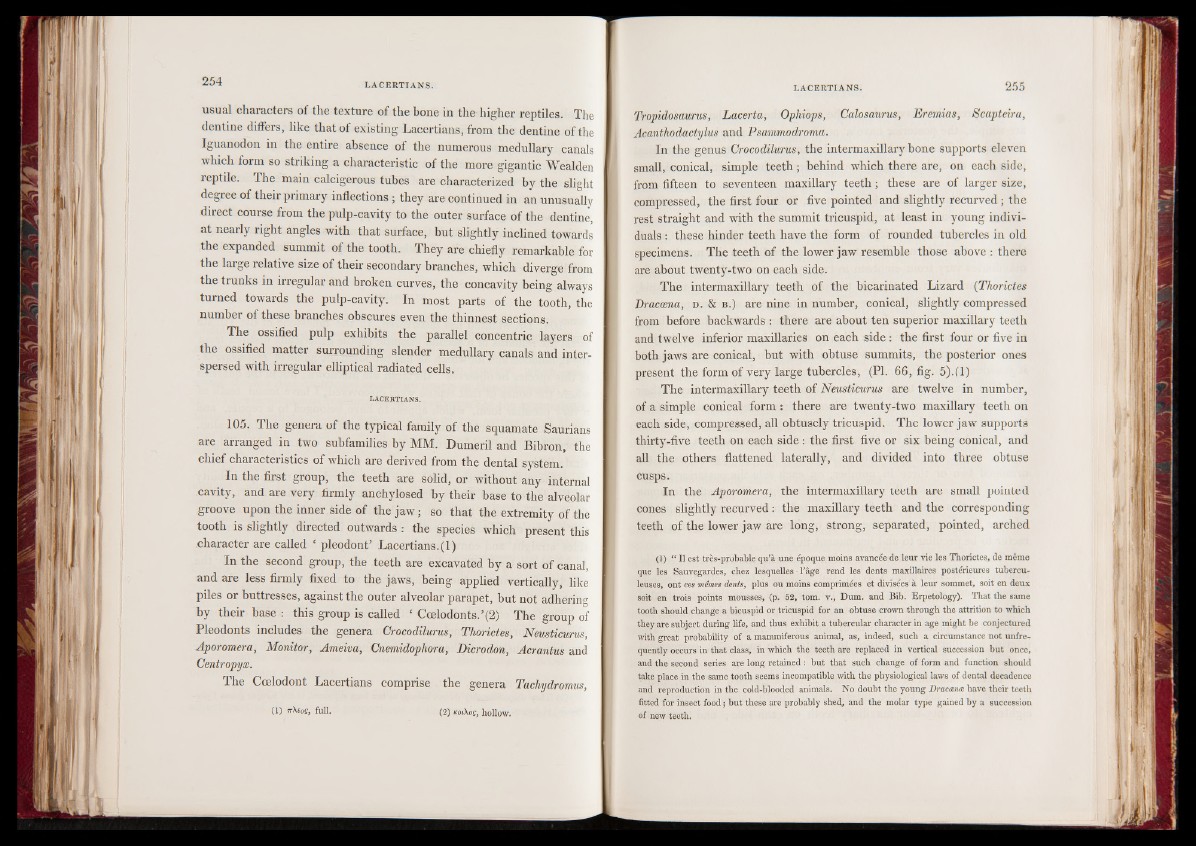
usual characters of the texture of the hone in the higher reptiles. The
dentine differs, like that of existing Lacertians, from the dentine of the
Iguanodon in the entire absence of the numerous medullary canals
which form so striking a characteristic of the more gigantic Wealden
reptile. The main calcigerous tubes are characterized by the slight
degree of their primary inflections ; they are continued in an unusually
direct course from the pulp-cavity to the outer surface of the dentine,
at nearly right angles with that surface, hut slightly inclined towards
the expanded summit of the tooth. They are chiefly remarkable for
the large relative size of their secondary branches, which diverge from
the trunks in irregular and broken curves, the concavity being always
turned towards the pulp-cavity. In most parts of the tooth, the
number of these branches obscures even the thinnest sections.
The ossified pulp exhibits the parallel concentric layers of
the ossified matter surrounding slender medullary canals and interspersed
with irregular elliptical radiated cells.
LACERTIANS.
105. The genera of the typical family of the squamate Saurians
are arranged in two subfamilies by MM. Dumeril and Bibron, the
chief characteristics of which are derived from the dental system.
In the first group, the teeth are solid, or without any internal
cavity, and are very firmly anchylosed by their base to the alveolar
groove upon the inner side of the jaw; so that the extremity of the
tooth is slightly directed outwards : the species which present this
character are called ‘ pleodont’ Lacertians.(1 )
In the second group, the teeth are excavated by a sort of canal,
and are less firmly fixed to the jaws, being applied vertically, like
piles or buttresses, against the outer alveolar parapet, but not adhering
by their base : this group is called ‘ Ccelodonts.’(2) The group of
Pleodonts includes the genera Crocodilurus, Thorictes, Neusticurus,
Aporomera, Monitor, Ameiva, Cnemidophora, Dicrodon, Acrantus and
Centropyx.
The Ccelodont Lacertians comprise the genera Tachydromus,
(1) irXtoC, full. (2) koiAos, hollow.
Tropidosaurus, Lacerta, Ophiops, Calosaurus, Eremias, Scapteira,
Acanthodactylus and Psammodroma.
In the genus Crocodilurus, the intermaxillary hone supports eleven
small, conical, simple teeth ; behind which there are, on each side,
from fifteen to seventeen maxillary teeth ; these are of larger size,
compressed, the first four or five pointed and slightly recurved ; the
rest straight and with the summit tricuspid, at least in young individuals
: these hinder teeth have the form of rounded tubercles in old
specimens. The teeth of the lower jaw resemble those above : there
are about twenty-two on each side.
The intermaxillary teeth of the bicarinated Lizard (Thorictes
Draccena, d . & b .) are nine in number, conical, slightly compressed
from before backwards : there are about ten superior maxillary teeth
and twelve inferior maxillaries on each side : the first four or five in
both jaws are conical, hut with obtuse summits, the posterior ones
present the form of very large tubercles, (PL 66, fig. 5).(1)
The intermaxillary teeth of Neusticurus are twelve in number,
of a simple conical form : there are twenty-two maxillary teeth on
each side, compressed, all obtusely tricuspid. The lower jaw supports
thirty-five teeth on each side : the first five or six being conical, and
all the others flattened laterally, and divided into three obtuse
cusps.
In the Aporomera, the intermaxillary teeth are small pointed
cones slightly recurved : the maxillary teeth and the corresponding
teeth of the lower jaw are long, strong, separated, pointed, arched
(1) “ Il est très-prubable qu’à une époque moins avancée de leur vie les Thorictes, de même
que les Sauvegardes, chez lesquelles-l’âge rend les dents maxillaires postérieures tuberculeuses,
ont ces mêmes dents, plus ou moins comprimées et divisées à leur sommet, soit en deux
soit en trois points mousses, (p. 52, tom. v., Dum. and Bib. Erpetology). That the same
tooth should change a bicuspid or tricuspid for an obtuse crown through the attrition to which
they are subject during life, and thus exhibit a tubercular character in age might be conjectured
with great probability of a mammiferous animal, as, indeed, such a circumstance not unfre-
quently occurs in that class, in which the teeth are replaced in vertical succession but once,
and the second series are long retained : but that such change of form and function should
take place in the same tooth seems incompatible with the physiological laws of dental decadence
and reproduction in the cold-blooded animals. No doubt the young Dracaena have their teeth
fitted for insect food ; but these are probably shed, and the molar type gained by a succession
of new teeth.